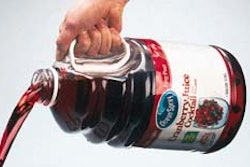From Newark Intl. airport, it’s about a half-hour’s drive north to Marcal Paper Mills’ Elmwood Park, NJ, plant. Pulling into Marcal’s main entrance, the 75-acre site seems sizeable enough to be a town by itself. The site’s buildings provide more than 2 million sq’ of space, dedicated to the manufacturing, packaging and distribution of paper products such as bathroom and facial tissues, paper towels and napkins.
Last year, the plant improved its packaging efficiency and space utilization, while reducing labor costs, by installing two robotic palletizing systems and two traditional or “in-line” palletizers. From OCME America (York, PA), the equipment was part of Marcal’s plant-wide initiative to increase efficiency and reduce costs.
Despite the facility’s expansive exterior, interior space is at a premium, particularly in the “converting” area where rolls of paper are converted into finished goods. Then they’re packaged into corrugated shipping cases or “poly-cased” film-wrapped bundles.
Until last January, the bulk of these packaged products were palletized manually. “Our converting operation usually runs three shifts per day, seven days per week,” explains Gordon Mayer, Marcal’s senior vice president of distribution and human resources.
“Upgrading of our converting operation required new equipment, including in-line palletizers and robotic palletizers,” he says. While the equipment was being installed, Marcal continued to manually palletize product loads. The company hired temporary employees to stack the production on pallets and take them to the shipping dock until the automatic palletizers were in place. “We expect that the labor savings from eliminating manual palletizing will generate a two-year payback on our investment,” Mayer states.
Overall process
Corrugated cases or plastic film-wrapped bundles of paper products are delivered from upstream packaging lines to the palletizers on 3귔’ of roller conveyor from Rapistan Systems (Grand Rapids, MI). Rapistan had overall system responsibility for the Marcal project.
Product is conveyed past an Accu-Sort Systems (Telford, PA) scanner. The scanner communicates with a host Modicon PLC from Schneider Automation (North Andover, MA), to sort cases or bundles, which are then diverted to the appropriate lane for palletizing.
Full pallet loads are subsequently stretch-wrapped by two new Lantech (Louisville, KY) units. Afterwards, pallet labelers from Labeling Systems (Oakland, NJ) apply pressure-sensitive bar-code labels, one to each of two adjacent sides of the wrapped pallet. These labelers are also equipped with Accu-Sort scanners that verify that the bar codes on each pallet are identical. This information is used for the company’s computerized warehouse management system. Marcal purchased the stretch wrappers and pallet labelers through Shrink Packaging Systems (Edison, NJ).
Paper products are initially produced in plastic, paper or corrugated packages. That primary package is either case-packed into a corrugated shipper or overwrapped in a plastic bundle. Marcal produces hundreds of SKUs at its Elmwood Park facility on various lines at the plant.
From each packaging line, cases or bundles are carried along zero-accumulation roller conveyors from Rapistan. The zero-accumulation conveyors are used to prevent crushing between cases. That’s done with plastic stops positioned between conveyor rollers, explains Geoffrey Zoeller, Marcal’s director of warehouse operations. “When a case stays on a stop, it effectively shuts off the section of the conveyor directly behind it so that the case on the previous section doesn’t drive into the leading case, creating damage,” he says.
The type of secondary package, along with the packaging line’s proximity to each palletizer, helps determine which machine will palletize which product.
All four OCME palletizers can accommodate cases or bundles, but only the two robotic systems can palletize bundles that go into a corrugated tray. This four-sided tray’s dimensions virtually match those of the pallet. The tray forms a stable base for some bundled products on the robotic palletizer. The in-line palletizers are not used when palletizing bundles in trays.
Robotic process
The OCME robotic palletizing installation at Marcal includes two robotic “cells,” each having four automated palletizing lanes. One robotic head picks and places packed products from four of the lanes, while the second robot does the same for the other four lanes. Both function independently, picking and placing packs from any of the four lanes rather than picking and placing all packs from one line before moving on to the next lane.
Between the two four-lane sections is a ninth lane. “This is a ‘no-read’ lane,” Zoeller explains. “It’s a lane for cases or bundles that for some reason are flawed. The bar code may not be readable, or a label may be missing. The pack goes to this lane so an operator can remove it to resolve a problem.”
The robotic system is controlled by a Modicon PLC. In operation, the robotic palletizing sequence begins as cases or bundles come from upstream packaging lines and are merged into a single lane. Before a pack is conveyed into one of the eight robotic system lanes, it passes the Accu-Sort scanner that reads the pack’s bar code. That information is relayed to the PLC, which in turn signals a mechanical “push-sorter” to push it onto the appropriate robotic lane.
The system is set up so that packs with the same SKU bar code are delivered to the same lane. For example, for a case designated with code number 3204, the system might be programmed to move that case to lane three for the current production run. The next time the company runs case code 3204, those cases may be programmed to run on lane seven.
Each product is carried along the motor-driven conveyor lanes until it reaches a stop. If that product needs to be stacked before it’s placed on a pallet, a stacker or piler is used. When the stacker lifts the product, the next product is conveyed under the lifted pack. The stacker then sets the first product back on top of the product on the conveyor. Then the conveyor delivers the double-deck stack to a precise pick area. From that location, the robotic gripper picks up the product. Unlike some robotic heads that use vacuum, this gripper uses plates to grasp and move the product to the appropriate pallet in the predetermined pallet stacking pattern.
Shuttle system
Meanwhile, the PLC signals for a two-level shuttle car that services all eight robotic discharge conveyor lanes. The shuttle conveys back and forth along tracks in the floor, perpendicular to the eight lanes. The PLC instructs the shuttle car to stop at the lane where the full pallet awaits pick-up.
When the car is in position, its upper-level transfer arms lower, creating a transfer point between the car and the discharge conveyor. The discharge conveyor, transfer arms and shuttle car each use two matching motor-driven chain conveyor sections, which are aligned when the shuttle car reaches a predetermined location at the end of the lane. The pallet is then transferred.
At the same time, on a lower-level tier of the shuttle car, other transfer arms lower so that an empty pallet can be transferred from the shuttle, across the transfer arms and onto the lower level of the discharge conveyor. The empty pallet is conveyed along this motor-driven chain conveyor to a position just downstream of the elevator so that it’s ready when the elevator needs to bring a new pallet into position for the robot to fill.
The OCME system also includes an “empty pallet cell” located at the end of the eight lanes, near the shuttle car’s “home” position. The cell contains a vacuum pick-up head that slides to its right or left to pick up either a paperboard slip sheet or corrugated bottom tray. The vacuum head places the sheet or tray on the empty pallet for the shuttle car to take and deliver to the appropriate robotic palletizing lane.
The shuttle car, which can carry two full pallets at a time, transfers the full pallet onto a conveyor that delivers it to the infeed of a Lantech S-3500 Straddle stretch wrapper that stretch wraps the pallet. The wrapped load exits the machine and is labeled on two sides by the LSI 3990 pallet labeler.
The LSI machine is equipped with a telescoping head. It applies a p-s bar-code label to the leading side of the wrapped pallet. It then uses an Accu-Sort scanner to read the bar code on the pallet. The head retracts and the load is turned 90? on an OCME turntable. Now the head applies an identical label to the adjacent side of the load. The Accu-Sort scanner reads the second bar code on the pallet. The scanner alerts Marcal if the information on the two labels does not match as it should.
The placement of the labels is important in that it makes it easier for forklift operators to scan the labels for warehouse and distribution purposes. Marcal delivers its products to customers with its own fleet of trucks, as well as by LTL and common carrier.
In-line process
The two in-line palletizers were also operational in early ’99. One was bought to replace an older OCME machine, the other to replace manual palletization. “On the replacement unit, we’ve been able to use the same conveyors we used for its predecessor,” notes Zoeller. “And that saved us some money.”
For the in-line palletizer, the process begins upstream, as product is carried on a conveyor from each packaging line. The conveyor lines merge into a single conveyor. This conveyor carries each case or bundle past an Accu-Sort scanner that reads the SKU bar code from the preprinted case. That information helps the system sort and deliver the pack into the appropriate accumulation conveyor lane. Eleven lanes feed this palletizer.
The SKUs differ by lane, but each of the 11 lanes accumulates one SKU at a time. Marcal has each SKU programmed into the PLC so that the system knows how many cases or bundles of a SKU are needed to fill a pallet. When that SKU’s full pallet quantity is accumulated on the lane, the system instructs that lane to discharge those cases. This pallet “slug” of cases is then conveyed to the palletizer.
At the time of Packaging World’s visit, Zoeller directed this editor to one of the two in-line palletizers to explain how they operate. At the infeed of the palletizer, another scanner reads the bar code to instruct the palletizer to use the appropriate pallet pattern.
“Cases are conveyed onto a forming table that arranges the packs into a single tier. Then a stripper bar pushes each layer onto a stripping table,” Zoeller points out. Side ‘dams’ are used to square the cases on this table. “Squaring off the layer of cases is important because when the stripping table doors open and release the cases onto the pallet, they have to be square. If there’s overhang on the pallet, you risk the possibility of cases falling and product damage.”
The pallet below the stripping table indexes up and down on an elevator system, moving up so that the cases drop only a short distance onto the pallet. The pallet descends with each new layer until it’s filled. Filled pallets discharge onto a conveyor and are carried a short distance to another Lantech wrapper and LSI pallet labeler.
System pleases Marcal
Mayer and Zoeller say Marcal has been quite pleased with the performance of its new palletizers. “We originally had more than one vendor quoting on this project,” Mayer recalls. “There are several manufacturers of robotic palletizers in the market. OCME was included in the bidding because of our previous relationship with them. But they won the bid because their ideas helped us meet our challenges of plant layout, and because of their ability to handle our products within our space constraints.”
With OCME headquartered in Italy, Marcal was initially concerned about service and support. “They sent personnel here and they were with us for all of last December and January,” Mayer recalls. “They also have an office in York, Pennsylvania, only a couple of hours away, so when we need them, they’re readily available. We’re very satisfied with the palletizers and the performance they’ve given us.
“This was a challenging project,” he concludes. “Rapistan had systems responsibility, but all our vendors worked in unison to make this happen.”
































